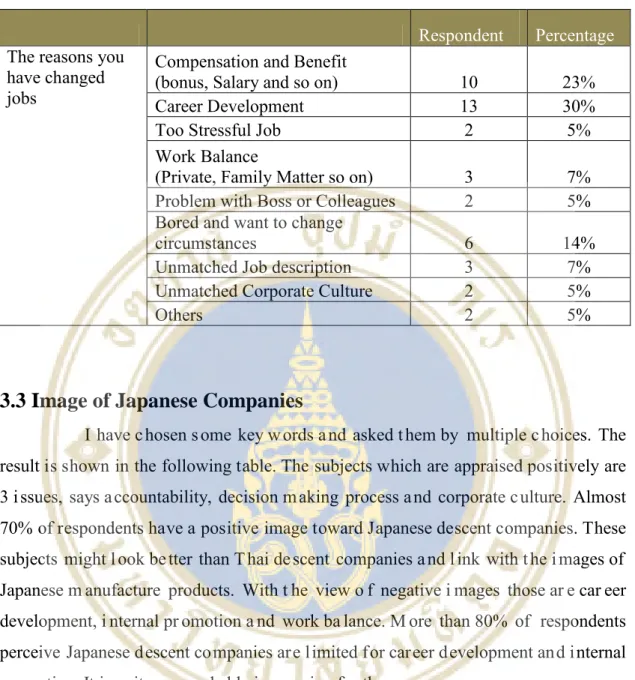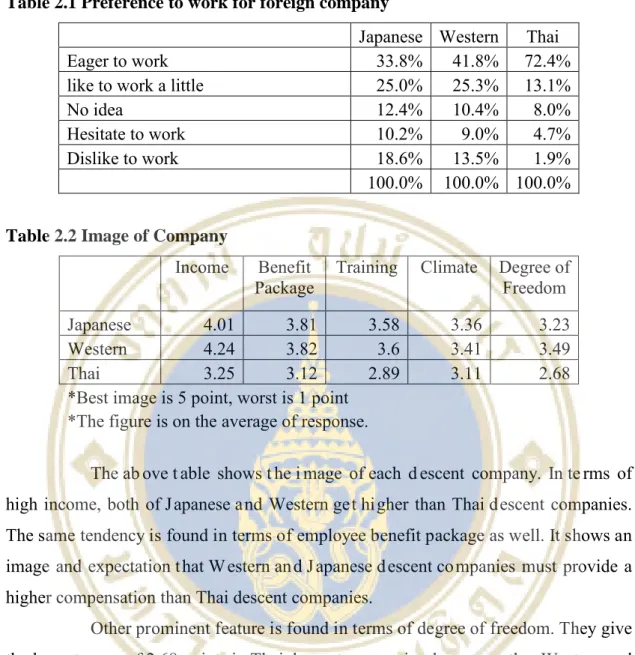I would like to express my sincere appreciation and thanks to the College of Management, Mahidol University for providing me with knowledge. IMPACT OF LOCALIZATION IN RECRUITMENT STRATEGY OF JAPANESE COMPANIES IN THAILAND CASE STUDY TO APPLY A JAPANESE SME. The paper uses secondary data from the questionnaire, a primary date of web survey and case study analysis by interviews.
Companies of Japanese origin can improve their employment position by providing career development and career path planning through the localization process. In terms of trade activity, in 2012 Japan ranked second (10.2%) in exports to China (11.7%) and first (20%) in imports. I found a questionnaire article detailing the ranking of popular companies for new university graduates, including nine universities in Bangkok.
It is easy to determine that the famous haichi companies should occupy his ranking and some of the Japanese and foreign companies should also be ranked higher in the ranking, however the truth was that I could not find any famous company Japanese except for Toyota and Honda in the top 30 ranking. In the second half I focus on a Japanese SME company named GIKO (Thailand) Co., Ltd. The company has faced a difficulty in recruiting Thais and a problem in retaining the firm's top skills.
I study the problems and reasons for the current situation with the context of Japanese companies in Thailand, and then generate the practical recommendations that can be applied from the first half.

PERCEPTION OF JAPANESE COMPANY FROM QUESTIONNAIRE TO NEW UNIVERSITY GRADUATES
Result of Questionnaire
In terms of high revenue, both Japanese and Western companies are higher than Thai-origin companies. It shows an image and expectation that companies of Western and Japanese origin should offer higher compensation than companies of Thai origin. They give the lowest score of 2.68 points to companies of Thai origin, however the other Western and Japanese ones hold 3.49 points and 3.23 points or each.
Analysis of Findings
As you can see their aversion to working for foreign companies, they especially want to work for companies of Thai origin. On the other hand, they have to face a dilemma because despite Thai favoritism, there is a mismatch between what they expect from the jobs and the perception of companies of Thai origin. At the same time, they get a detailed picture of companies of foreign origin in terms of compensation and training.
PERCEPTION OF JAPANESE COMPANY FROM THE STANDPOINT OF JOB CHANGERS
- Job History (See the table 1 and 2 in appendix B.)
- The Reasons to Change Jobs
- Image of Japanese Companies
- Analysis of Findings
The result is shown in the table below. The topics that are positively evaluated are 3 issues, accountability, decision-making process and corporate culture. These entities may look better than Thai-origin companies and be associated with images of Japanese-made products. With the negative view of car development, internal promotion and work balance.
More than 80% of respondents believe that Japanese-origin companies are limited in career development and internal promotion. In terms of image towards companies of Japanese origin, some issues are similar to those of new graduates. Job changers are also positive about the management style (responsibility and decision-making process) and the company culture.
It is also proven by the same in comparison with recent graduates that Japanese companies provide higher compensation and benefits than companies of Thai origin, but lower than companies of Western origin. Job role and responsibility respondent looks vague, says negative and positive reactions are counterbalanced. More than 80% of respondents believe that Japanese companies have a limitation in career development and internal promotion.
It is clear that they feel a reluctance to choose Japanese companies because of these negative images and perceptions.

RECOMMENDATIONS TO ACQUIRE AND RETAIN HIGH TALENT EMPLOYEES
- Compensation Level is Lower than Western Descent Companies
- Career Development Oriented Job Change
- Dislike SME and Prefer Large Company
- Thai Favoritism
In terms of corporate size, most Japanese-origin companies are similar to Thai SME companies, but to evaluate their real strength, we need to consider the whole structure of corporate family. The firm can provide a training opportunity in Japan and other countries and also provide career opportunities to work in its companies outside the countries. To challenge the ethnocentrism, the first requirement is to share the universal vision and values, then try to constantly communicate and build a common sense through universal standards.
T he company cannot transmit the information that appeals the firm is not an implied functional subsidiary of a foreign parent company. The importance of subsidiary is quite high in the company group and the success of employees' career is also promised. Because the company assigns local talent as top management and in some cases also assigns it to its subsidiary companies.
This type of message strongly influences the improvement of the corporate image and consequently attracts top local talent.
THEORETICAL FRAMEWORK
- What is Localization?
- Why Localization is Required?
- Localization Process
- Career Development and Succession Planning
From the perspective of local employees, expatriates consistently occupying top management positions are seen as an obstacle to internal promotion. This is the most effective way to reduce turnover and retain a large pool of talent within the company. Japanese expatriates not only receive the same salary in their parent companies, but are also mostly entitled to benefits and allowances abroad.
To address its process, the first thing to do is to motivate the expatriates to promote localization, which should be led by the parent company. After the preparation of the base network, three dimensions in the localization stage should be considered, say "Selection", "Motivation" and "Develop experiences for local employees". Firstly, it is to find local top talent, which should be developed, and secondly, to retain the local talent.
First of all, the marketing approach in human resources is effective in this matter. The company should improve the visible presence in local labor markets through publication, affiliation of educational institutions and scholarships, etc. The most important issues of an attractive compensation are to do with career development and involvement in decision making.
As mentioned in the localization process, career development and succession planning for the replacement of expatriates is essential and one of the most important success factors. First is the appropriate performance management system, then through an assessment of a performance, where we analyze the talent of each employee. The next step is to select the talent group, and finally we provide for the development of career paths through individual development plans, coaching (Mentoring) and performance assessment.
Glass ceiling issues are sometimes discussed in this context, initially it is a barrier to advancement to higher level jobs in the company that affects women and minorities, but in the context of localization we should consider it from the point of view of local employees. This means identifying and tracking high-potential employees who are capable of filling leadership positions at a higher level. It takes a lot of time due to turnover or he/she may change to poor performance, otherwise individual preferences and so on.
APPLYING A JAPANESE SME COMPANY CASE STUDY OF GIKO (THAILAND) CO., LTD
- Company Profile
- Current Business Situation
- The Organizational Problems
- Human Resource Management
- No Road Map to Educate Technicians
- Difficulty to Connect with Thai Human Network and Community
- Heavily Dependence to Japanese Expatriates and Japanese Parent Company
- SWOT Analysis from Human Resource Perspective
- Strength
- Weakness
- Opportunity
- Threat
- Problem Statements from HR Perspective
- Lack of Internal Training
- Difficulty to Recruit Potential Candidates
- Less Strategic Approach
- Recommendations
- Selection Process
- Motivations
- Development Process
- Impact to the Bottom Line
- Obstacles and How to Deal It?
From the interview with the president, I recognize some issues that the company is facing and struggling with today. As a result, the company is highly dependent on contributions from Japanese expatriates and support from the parent company from Japan. At the start of the foundation, the company has a Thai director as one of the shareholders, who has a strong connection to dentists and educational institutions.
They have a flat-rate organization and treat employees very flexibly, so the company accepts one employee in flexible working hours, because after finishing working hours she starts studying at the university. The parent company has ongoing facilities for the education and care of dental technicians, and the company can utilize this talent pool at a lower cost in the foam of Japanese expatriates. One of the competitive advantages of the company is the high quality of the products, which has never turned into organizational knowledge, since all production processes are carried out by Japanese expatriates.
The company could play a core center for training and career development for technicians. Higher pay and benefits from other industries make it difficult for the company to attract highly talented employees. Some employees are also solicited from competitors with the aim of competitors gaining knowledge of the company.
Next, the company would commit and create a schedule to strategically translate ad-hoc corporate policies through the localization process. Second, they emphasize the future plan for the candidate. Then the company offers a series of vocational training and opportunities to send them to the Japanese parent company to acquire the technical knowledge and company values. Once a new KSA is organized, the company should address the improvement of performance assessment based on the new KSA at each position and also design the skill.
Moreover, it is not a simple subsidiary, but takes a strategic role in the company's family. The company must no longer be able to manage its diverse situation in the traditional Japanese way. The company, which cannot illustrate the future image of the employees' career success, has no way to pluck every single top talent from the local labor market.
Thus, the investment in human resources is directly related to the improvement of quality and product for the company. At the beginning of its establishment, the company had hired a Thai local director, but this was left out.
CONCLUSION
APPENDICES
Appendix B. Questionnaire to Job Changers
Joy』Contributing to people's health, we strive to bring as much joy as possible to as many people as possible. We strive to create workplaces conducive to the health, well-being and satisfaction of all our employees. We will cultivate new businesses and markets in dental technology and expand this field globally.
We will meet patients directly to produce dental devices that meet their needs. We will work to create original dental technology by nurturing dental technicians who have acquired their unique professional skills. GIKO Smile (Focusing on dental customers) You can get mouth accessories just by the impression of your teeth.

